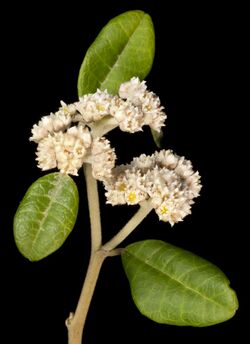Biology:Spyridium globulosum
| Spyridium globulosum | |
|---|---|

| |
| Scientific classification | |
| Kingdom: | Plantae |
| Clade: | Tracheophytes |
| Clade: | Angiosperms |
| Clade: | Eudicots |
| Clade: | Rosids |
| Order: | Rosales |
| Family: | Rhamnaceae |
| Genus: | Spyridium |
| Species: | S. globulosum
|
| Binomial name | |
| Spyridium globulosum (Labill.) Benth.[1]
| |
| Synonyms[1] | |
|
List
| |
Spyridium globulosum, commonly known as basket bush,[2] is a species of flowering plant in the family Rhamnaceae and is endemic to coastal areas in the south-west of Western Australia. It is a shrub with relatively large leaves and heads of flowers covered with whitish hairs.
Description
Spyridium globulosum is an erect shrub that typically grows to a height of 0.6–5 m (2 ft 0 in–16 ft 5 in), its young stems covered with short white or off-white hairs. The leaves are egg-shaped or oblong, 25–50 mm (0.98–1.97 in) long and 10–37 mm (0.39–1.46 in) wide, with small, thick stipules at the base. The leaves are mostly glabrous above but covered with grey, white or rust-coloured hairs on the lower surface. The heads of flowers are more or less spherical and arranged in dense cymes in leaf axils, the heads rarely longer than the leaves. The sepals are about 3 mm (0.12 in) long and joined at the base, forming a bell-shaped tube with softly-hairy bracts shorter than the sepals, at the base, the flowers covered with white hairs. Flowering occurs from June to November. Populations in the Perth area have leaves that are covered with white hairs on both surfaces.[2][3][4]
Taxonomy
Basket bush was first formally described in 1805 by Jacques Labillardière who gave it the name Ceanothus globulosus in his Novae Hollandiae Plantarum Specimen.[5][6] In 1863, George Bentham changed the name to Spyridium globulosum.[4][7] The specific epithet (globulosum) means "globe-shaped".[8]
Distribution and habitat
Spyridium globulosum grows on coastal sand dunes and on limestone in near-coastal areas in the Esperance Plains, Geraldton Sandplains, Hampton, Jarrah Forest, Mallee, Swan Coastal Plain and Warren bioregions of south-western Western Australia.[2]
References
- ↑ 1.0 1.1 "Spyridium globulosum". Australian Plant Census. https://biodiversity.org.au/nsl/services/apc-format/display/116023.
- ↑ 2.0 2.1 2.2 "Spyridium globulosum". FloraBase. Western Australian Government Department of Parks and Wildlife. https://florabase.dpaw.wa.gov.au/browse/profile/4828.
- ↑ Rye, Barbara L. (1996). "A synopsis of the genera Pomaderris, Siegfriedia, Spyridium and Trymalium (Rhamnaceae) in Western Australia.". Nuytsia 11 (1): 117–121. https://www.biodiversitylibrary.org/item/225336#page/123/mode/1up. Retrieved 22 July 2022.
- ↑ 4.0 4.1 Bentham, George; von Mueller, Ferdinand (1863). Flora Australiensis. 1. London: Lovell Reeve & Co.. p. 429. https://www.biodiversitylibrary.org/item/3669#page/487/mode/1up. Retrieved 22 July 2022.
- ↑ "Ceanothus globulosus". APNI. https://id.biodiversity.org.au/instance/apni/460794.
- ↑ Labillardière, Jacques (1805). Novae Hollandiae Plantarum Specimen. 1. Paris. p. 61. https://www.biodiversitylibrary.org/item/126969#page/60/mode/1up. Retrieved 22 July 2022.
- ↑ "Spyridium globulosum". APNI. https://id.biodiversity.org.au/instance/apni/550882.
- ↑ Sharr, Francis Aubi; George, Alex (2019). Western Australian Plant Names and Their Meanings (3rd ed.). Kardinya, WA: Four Gables Press. p. 207. ISBN 9780958034180.
Wikidata ☰ Q7581778 entry
 |


